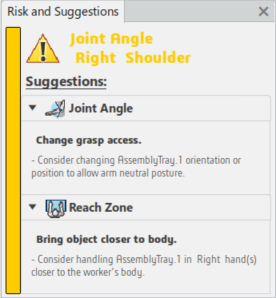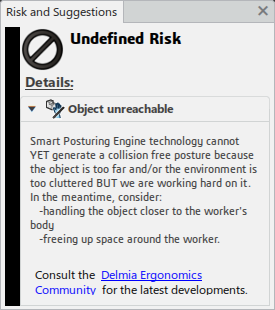Risk and Suggestions Dialog Box | ||
| ||
General Risks
Click under each Suggestion to expand the suggested posture.
This panel shows two zones of information:
- Results of the Risk analyze for the current human posture.
- Suggestions that arise from these analyze. These suggestions intend to reduce the risk level for the posture.
- The first zone gives the following information from the Risks analyses:
- The risk level.
- The type of the risk:
- weight
- joint load and
- joint angle.
- The side of the risk: right or left side of the joint defined as the risk’s location. In the case, of the latter has no side, such as the back or the neck, then this information remains empty.
- The location of the risk: shoulder / back / neck / elbow / wrist.
Risk Types:
- Weight - The risk of injuries is directly triggered by the weight of the object involved in the Worker Task as this weight exceeds the maximum suggested value based of the gender of the worker. Referencing Mittall and Coll. 1997. Also, as suggested by the specification EN1005-2 this maximum weight is dependent if an action performs with one or both hands.
- Joint Angles - This type of risk indicates that at least one joint has an angle that can lead to a potential risk of injuries. Analyzed limits for the joints angles are based on specifications such as EN1005-4, ISO 11226 and ISO 11228-3.
- Joint Load - This type of risk computed from specification EN1005-3 indicates a potential risk related to the loads applied on the joints by taking into consideration the Task Specifications of the analyzed WorkerTask such as frequency of the action, action time, action speed and, worked hours.
- The second zone displays through expanding, the suggestions for the risk type and the analyzed Reach Zone. Although is not related to any Risk Type, the Reach Zone analysis provides more details on how to lower the risk for the workers.
Undefined Risk
Work tasks that do not have a posture validated by the SPE present an undefined level of
risk, therefore makes no suggestion. But it provides a detailed explanation to help
you.
These details fall into 4 categories:
- Object Excessive Weight - The weight of the targeted object is exceeding the maximum weight to lift for a human. These maximum values are related to the gender and issued from NIOSH Lifting Guidelines and GROSS, Michael T., DAILEY, Ennea S., DALTON, Melissa D., et al. Relationship between lifting capacity and anthropometric measures. Journal of Orthopedic and Sports Physical Therapy, 2000, vol. 30, no 5, p. 237-262.
- Object Unreachable - The targeted object cannot be reached for
at least one of these reasons:
- Location too far, too low or out of reach
- Reaching causes a collision.
- Posture Out Of Balance - No valid and realistic posture has been achieved by the SPE.
- Object Not Visible - The targeted object remains not visible and thus no valid and realistic posture has been achieved by the SPE.